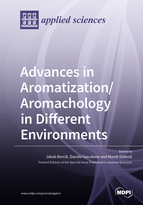Advances in Aromatization/Aromachology in Different Environments
A special issue of Applied Sciences (ISSN 2076-3417). This special issue belongs to the section "Food Science and Technology".
Deadline for manuscript submissions: closed (30 June 2021) | Viewed by 24122
Special Issue Editors
Interests: consumer neuroscience; market research; marketing; consumer behavior; retailing; e-commerce
Interests: sensory science; consumer behavior; context; product experience
Special Issues, Collections and Topics in MDPI journals
Special Issue Information
Dear Colleagues,
This Special Issue is devoted to research advances and application of aromachology. Aromachology uses various specific aromatic compounds to enhance and stimulate the senses, create appropriate emotions and activate certain biochemical processes. Its impact on human emotions can be examined not only through traditional research approaches but by using biometric and neuroimaging tools too.
The Special Issue connects interdisciplinary approaches of neuroscience and information technologies for the effective and efficient aromatization of spaces. In addition, an essential part of aromachology research is the consideration of air quality, which has a fundamental impact on unconscious human perception.
We seek submissions ranging from the exploration of applications of aromachology. Papers focusing on methodological issues and technological solutions for aromachology are especially welcome.
Topics of interest include:
- Aromachology in healthcare;
- Industrial applications of aromachology;
- Health-promoting applications of aromachology;
- Methodological issues in aromachology research;
- Technological advancements and smart research solutions in aromachology.
Dr. Jakub Bercik
Prof. Dr. Davide Giacalone
Prof. Dr. Marek Dolezal
Guest Editors
Manuscript Submission Information
Manuscripts should be submitted online at www.mdpi.com by registering and logging in to this website. Once you are registered, click here to go to the submission form. Manuscripts can be submitted until the deadline. All submissions that pass pre-check are peer-reviewed. Accepted papers will be published continuously in the journal (as soon as accepted) and will be listed together on the special issue website. Research articles, review articles as well as short communications are invited. For planned papers, a title and short abstract (about 100 words) can be sent to the Editorial Office for announcement on this website.
Submitted manuscripts should not have been published previously, nor be under consideration for publication elsewhere (except conference proceedings papers). All manuscripts are thoroughly refereed through a single-blind peer-review process. A guide for authors and other relevant information for submission of manuscripts is available on the Instructions for Authors page. Applied Sciences is an international peer-reviewed open access semimonthly journal published by MDPI.
Please visit the Instructions for Authors page before submitting a manuscript. The Article Processing Charge (APC) for publication in this open access journal is 2400 CHF (Swiss Francs). Submitted papers should be well formatted and use good English. Authors may use MDPI's English editing service prior to publication or during author revisions.
Keywords
- aromachology
- scents
- behavior
- aroma








